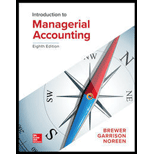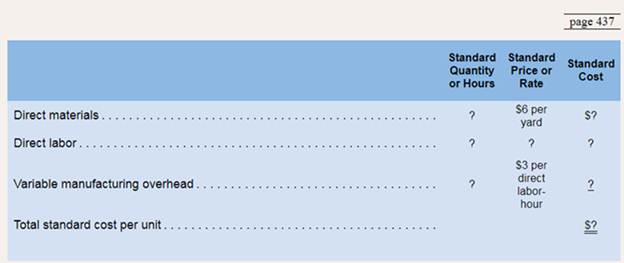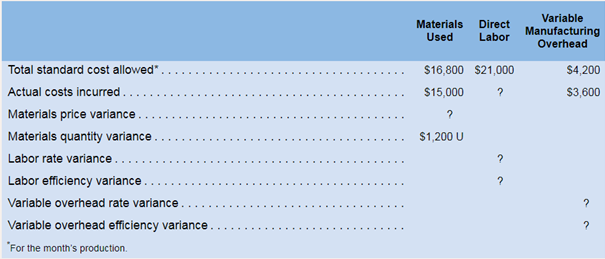
Concept explainers
Comprehensive
Highland Company produces a lightweight backpack that is popular with college students. Standard variable costs relating to a single backpack are given below: 

The following additional information is available for March’s production:

Required: (Hint: It may be helpful to complete a general model diagram for direct materials, direct labor, and variable manufacturing overhead before attempting to answer any of the requirements.)
1. What is the
2. What was the actual cost per backpack produced during March?
3. How many yards of material arc required at standard per backpack?
4. What was the materials price variance for March if there were no beginning or ending inventories of materials?
5. What is the standard direct labor rate per hour?
6. What was the labor rate variance for March? The labor efficiency variance?
7. What was the variable overhead rate variance for March? The variable overhead efficiency variance?
8. Prepare a standard cost card for one backpack.
1
Standard cost
It is the budgeted or estimated cost that a company plan to incur in manufacturing goods. This cost is then compared to the actual incurred cost.
To calculate: Standard cost of one backpack.
Answer to Problem 26P
Standard cost of one backpack is$42.
Explanation of Solution
Standard cost of one backpack will be calculated by dividing total standard cost by total number of backpacks.
Total standard cost is
And total 1,000 backpacks are produced by the company in the month of march. So, standard cost for one backpack will be:
Standard cost of a single backpack is $42.
2
Actual cost
This is the amount of money incurred by a company in the production of products.
To calculate: Actual cost incurred for one backpack.
Answer to Problem 26P
Actual cost for one backpack is $41.25.
Explanation of Solution
Actual cost per backpack can be calculated by deducting difference between standard and actual cost from the standard cost of one backpack. Here, difference is given as 0.15$ (favorable) and standard cost is $42 (computed in subpart 1). So, the actual cost will be:
So, the actual cost of one backpack is $41.85.
3
Materials
Materials are used by companies to make their final product. Certain processes are performed on the materials and it is then converted into a finished product.
To calculate: Yards of material required by company for each backpack.
Answer to Problem 26P
Company requires 2.8 yards for each backpack.
Explanation of Solution
Number of yards required for standard per backpack can be calculated by dividing standard material cost (per backpack) by standard material cost of one yard.
Here, standard cost of material per yard is given is $6 and standard cost of material for each backpack will be calculated as:
Now, number of yards required by the company will be calculated as:
Therefore, 2.8 yards are required for each backpack.
4
Material price variance
This variance represents the difference between actual cost incurred and standard cost of acquiring materials.
To calculate: Amount of favorable or unfavorable material price variance.
Answer to Problem 26P
Material price variance is
Explanation of Solution
Material price variance will be calculated by the following formula:
Here, material quantity variance is given as $1,200 (U) and total material variance can be calculated as:
So, amount of material price variance will be:
So, material price variance is $3,000 F.
5
Standard labor rate
These are the labor rates calculated by a company using certain standards. Standard labor hours are compared with the actual labor hours used and any difference found is minimized.
To calculate:Amount of per hour standard rate for direct labor rate.
Answer to Problem 26P
Standard labor rate per hour is $15 per direct labor hour.
Explanation of Solution
Standard rate per hour direct labor hours will be calculated by the following formula:
Here, total standard cost of direct labor is given as $21,000 and standard direct labor hours can be calculated as:
Now, calculation for standard direct labor rate per hour will be done as:
Per hour standard rate is $15 per direct labor hour.
6
Labor rate variance
This variance represents the difference between actual value incurred on labors and value that was expected to be incurred.
Labor efficiency variance
This variance represents the difference between actual hours of labor used while producing units and hours that were budgeted to be used. It shows how effectively labor hours are utilized.
To calculate:Amount of labor rate and efficiency variances.
Answer to Problem 26P
Labor rate variance is $750 unfavorable and labor efficiency variance is $1,500 unfavorable.
Explanation of Solution
Formula to calculate labor efficiency variance is
Here, actual labor hours are given as 1,500, standard hours are 1,400 (computed under sub part 5) and standard rate is $15 (computed under sub part 5).
So, the variance will be calculated as:
For calculating labor rate variance, actual direct labor cost and actual direct labor hours are needed to be calculated.
Calculation of actual direct labor cost:
| Particulars | Amount (in $) |
| Total cost of production (41.85 * 1,000) | 41,850 |
| Less: actual material cost | (15,000) |
| Less: actual variable manufacturing overhead cost | (3,600) |
| Actual direct labor cost | 23,250 |
Now, actual labor hours will be calculated as:
Now, labor rate variance will be calculated as:
So, labor rate variance is $750 unfavorable and labor efficiency variance is $1,500 unfavorable.
7
Variable overhead rate variance
This variance shows the difference between the actual amount incurred by a company on certain variable overheads and the amount that was budgeted to be incurred.
Variable overhead efficiency variance
This variance shows the difference between actual overhead production hours and hours that were budgeted using certain standards.
To calculate:Amount of variable overhead rate and efficiency variances.
Answer to Problem 26P
Variable overhead rate variance is $900 favorable and variable overhead efficiency variance is $300 unfavorable.
Explanation of Solution
Calculation of variable overhead rate variance when actual hours are given as 1,500, standard rate is $3 per hour and actual labor cost is $3,600:
Calculation of variable overhead efficiency variance:
So, variable overhead rate variance is $900 favorable and variable overhead efficiency variance is $300 unfavorable.
8
Standard cost card
A standard cost card contains helps in calculating the total standard cost of one unit by showing information about standard rate, price, quantity and hours.
To prepare:A standard cost card showing the total standard cost.
Answer to Problem 26P
Total standard cost per backpack is $42.
Explanation of Solution
Standard cost card will be prepared as follows:
| Particulars | Standard quantity or standard hours | Standard price or standard rate | Standard cost |
| Direct material | 2.8 | $6 | $16.80 |
| Direct labors (calculated below) | 1.4 | $15 | $21 |
| Variable manufacturing overheads for direct labor hours | 1.4 | $3 | $4.2 |
| Total standard cost | $42 |
Calculation of direct labor hours per backpack:
Want to see more full solutions like this?
Chapter 9 Solutions
Introduction To Managerial Accounting
 Managerial Accounting: The Cornerstone of Busines...AccountingISBN:9781337115773Author:Maryanne M. Mowen, Don R. Hansen, Dan L. HeitgerPublisher:Cengage Learning
Managerial Accounting: The Cornerstone of Busines...AccountingISBN:9781337115773Author:Maryanne M. Mowen, Don R. Hansen, Dan L. HeitgerPublisher:Cengage Learning Cornerstones of Cost Management (Cornerstones Ser...AccountingISBN:9781305970663Author:Don R. Hansen, Maryanne M. MowenPublisher:Cengage Learning
Cornerstones of Cost Management (Cornerstones Ser...AccountingISBN:9781305970663Author:Don R. Hansen, Maryanne M. MowenPublisher:Cengage Learning Managerial AccountingAccountingISBN:9781337912020Author:Carl Warren, Ph.d. Cma William B. TaylerPublisher:South-Western College Pub
Managerial AccountingAccountingISBN:9781337912020Author:Carl Warren, Ph.d. Cma William B. TaylerPublisher:South-Western College Pub Financial And Managerial AccountingAccountingISBN:9781337902663Author:WARREN, Carl S.Publisher:Cengage Learning,
Financial And Managerial AccountingAccountingISBN:9781337902663Author:WARREN, Carl S.Publisher:Cengage Learning, Principles of Cost AccountingAccountingISBN:9781305087408Author:Edward J. Vanderbeck, Maria R. MitchellPublisher:Cengage Learning
Principles of Cost AccountingAccountingISBN:9781305087408Author:Edward J. Vanderbeck, Maria R. MitchellPublisher:Cengage Learning Excel Applications for Accounting PrinciplesAccountingISBN:9781111581565Author:Gaylord N. SmithPublisher:Cengage Learning
Excel Applications for Accounting PrinciplesAccountingISBN:9781111581565Author:Gaylord N. SmithPublisher:Cengage Learning





